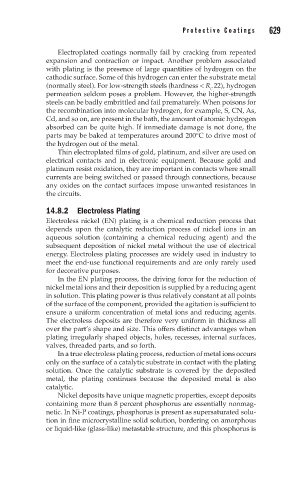Page 675 - Corrosion Engineering Principles and Practice
P. 675
628 C h a p t e r 1 4 P r o t e c t i v e C o a t i n g s 629
Electroplated coatings normally fail by cracking from repeated
expansion and contraction or impact. Another problem associated
with plating is the presence of large quantities of hydrogen on the
cathodic surface. Some of this hydrogen can enter the substrate metal
(normally steel). For low-strength steels (hardness < R 22), hydrogen
C
permeation seldom poses a problem. However, the higher-strength
steels can be badly embrittled and fail prematurely. When poisons for
the recombination into molecular hydrogen, for example, S, CN, As,
Cd, and so on, are present in the bath, the amount of atomic hydrogen
absorbed can be quite high. If immediate damage is not done, the
parts may be baked at temperatures around 200°C to drive most of
the hydrogen out of the metal.
Thin electroplated films of gold, platinum, and silver are used on
electrical contacts and in electronic equipment. Because gold and
platinum resist oxidation, they are important in contacts where small
currents are being switched or passed through connections, because
any oxides on the contact surfaces impose unwanted resistances in
the circuits.
14.8.2 Electroless Plating
Electroless nickel (EN) plating is a chemical reduction process that
depends upon the catalytic reduction process of nickel ions in an
aqueous solution (containing a chemical reducing agent) and the
subsequent deposition of nickel metal without the use of electrical
energy. Electroless plating processes are widely used in industry to
meet the end-use functional requirements and are only rarely used
for decorative purposes.
In the EN plating process, the driving force for the reduction of
nickel metal ions and their deposition is supplied by a reducing agent
in solution. This plating power is thus relatively constant at all points
of the surface of the component, provided the agitation is sufficient to
ensure a uniform concentration of metal ions and reducing agents.
The electroless deposits are therefore very uniform in thickness all
over the part’s shape and size. This offers distinct advantages when
plating irregularly shaped objects, holes, recesses, internal surfaces,
valves, threaded parts, and so forth.
In a true electroless plating process, reduction of metal ions occurs
only on the surface of a catalytic substrate in contact with the plating
solution. Once the catalytic substrate is covered by the deposited
metal, the plating continues because the deposited metal is also
catalytic.
Nickel deposits have unique magnetic properties, except deposits
containing more than 8 percent phosphorus are essentially nonmag-
netic. In Ni-P coatings, phosphorus is present as supersaturated solu-
tion in fine microcrystalline solid solution, bordering on amorphous
or liquid-like (glass-like) metastable structure, and this phosphorus is

